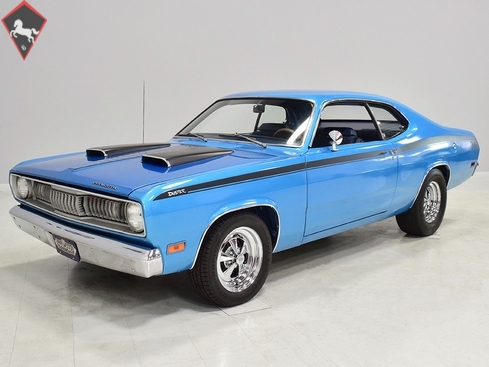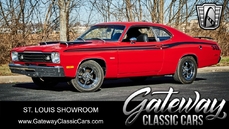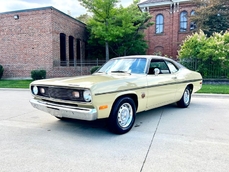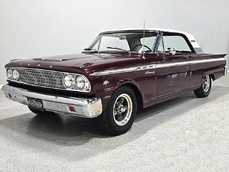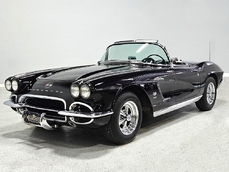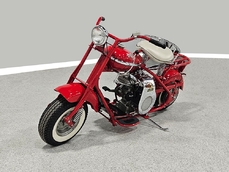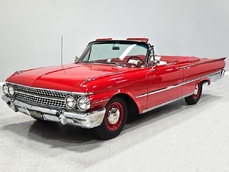Plymouth Duster 340 cubic inch V8 1971
General description :
In the performance world, taking weight out is the same as putting horsepower in. But what if you did both? Enter the Plymouth Duster, a plebian commuter car on the surface, but if optioned properly, you get one of the nastiest compacts of the early 1970s. Much like the Chevy Nova, engineers found that stuffing a V8 in their Duster created a car that could intimidate the hell out of much more powerful (and expensive) machinery. And they could do it on a budget!
All of that remains true today, as this 1971 Plymouth Duster 340 might be the biggest bang for the buck in our inventory. This is a real 340 car, documented with the original Chrysler Corporation Broadcast Sheet and fender tag, and it is most definitely built for combat. Here’s the rest of the information that you’ll be wanting to see from the fender tag:
Plymouth Valiant, Duster
Special 2-door sports hardtop
H1B: 340 cubic inch 275 horsepower 4-barrel V8
1971 model year
Dodge Main, Hamtramck, MI, USA assembly plant
115129: Sequence number
E55: 340 cubic inch 4-barrel V8, 275 horsepower
D32: Heavy-duty automatic transmission
GB5: Bright Blue Poly exterior color
L1B7: Trim, Blue
CB7: Dark Blue Poly interior door frames
902: Build date: September 02
B07754: Order number
CB5: Bright Blue Poly top color
C: Canada specifications
M21: Roof drip rail moldings
N41: Dual exhaust
N42: Chrome exhaust tips
V6X: Longitudinal stripes, Black
V8X: Tranverse stripes, Black
EN2: End of sales codes
You’ll note that the car was originally delivered to Canada, and we have the original bill of sale from Johnston Motor Sales Co. in Sanford, Hamilton Ontario. It shows a purchase price of $3495 including the automatic transmission and AM radio, plus a trade-in of a 1969 Ford 2-door sedan worth $1147. Out-the-door, Mr. Harold Crawford drove his new 1971 Duster 340 home for just $2500.40, making it one heck of a performance bargain in anyone’s book.
We don’t have a lot of history after Harold took it home, but the sheetmetal appears to be all original so there are no patches and no crappy reproduction body panels. It was repainted several years ago in the original B5 Blue, a popular Mopar color that works rather well on the intense little Duster. It isn’t show-quality, but it’s about right for a car that is so reasonably priced, then and now. You could probably give it a wet sand and buff to really bring out a shine, but even as it sits, the chunky little Duster looks great. Correct Duster 340 graphics were installed on the flanks and hood, as well as a set of Chrysler’s popular twin hood scoops which make this compact look more than a little nasty. All the chrome and stainless trim appears to be in good original condition and even details like the grille and taillights reflect the car’s easy previous life. This is a car that’s ready, willing, and able to have fun.
The blue cloth and vinyl interior is nicely restored using correct materials and patterns. It’s not dated, and the checkered cloth is a nice step up from the usual vinyl. The front bench looks purposeful and has no popped seams or notable wear, and there’s still a comfortable spring to it when you slide behind the wheel. Sure, it’s a bench seat car with a column shifter, but remember that these cars were not about upgrades and expensive options, they were performance on a budget and this car delivers in spades. Rubber floor mats are a reminder of the car’s working-class roots, but I don’t think anyone will complain about the accommodations once the engine cackles to life. The original wheel has been replaced by a handsome wood-rimmed unit, and things like the woodgrained applique on the instrument panel and factory gauges are in good shape with only slight fading. And while this Duster carries a full array of factory instruments, someone has thoughtfully added an oil pressure gauge in the center of the dash and a big Auto Meter tach to better monitor the engine’s vitals. The transmission is a 727 TorqueFlite 3-speed automatic with a manual valve body, so you do have to shift it yourself, but you’ll find that it’s actually a lot of fun to click the shifter through the gears and feel the transmission shift instantly—you can probably bark the tires on the 2-3 shift if you’re running hard. The original AM radio is still in the center of the dash, but it’s probably due for an upgrade (or not, because I bet you’ll never want to use the radio in this car). The only real issue is a headliner that’s wrinkly, but a professional upholsterer could probably take care of that in an hour or two. The trunk is obviously original and you can see that there’s exactly zero rust in this car and that it still sports its original quarters, floors, and trunk extensions, and there’s a reproduction mat on top to make it look right.
What this Duster really does best is hammer down the road, mostly thanks to the freshly built 340 cubic inch V8 living under the hood. It would be a mistake to dismiss this small block, as more than a few guys in their 440 ‘Cudas were embarrassed by similar cars back in the day. This one is even more potent, having been recently rebuilt with an upgraded cam that gives it a lopey idle, an Edelbrock 600 CFM 4-barrel carburetor on a Weiand intake manifold, and beautiful ceramic-coated long-tube headers that help build torque. It is indeed beautifully detailed with Hemi Orange paint on the block, finned Mopar Performance valve covers, and a chrome air cleaner, but the most remarkable thing is that when you turn the key, it springs to life almost instantly and idles well even when it’s cold. The guys at Customs Unlimited spent a lot of time tuning this one to get it right. You’ll note that the bright blue paint in the engine bay is just as nice as the rest of the body, and almost every single external component is new, not just cleaned up and bolted back on. There’s easily twice the asking price wrapped up in the restoration.
Underneath it’s the same story: sanitary and solid, if not perfectly clean and detailed. The aforementioned TorqueFlite was rebuilt with a modest torque converter and manual valve body, but it doesn’t need a lot of throttle to get it rolling, so it’s not over-done. There’s a fresh 8.75-inch rear end out back with 3.73 gears inside, so it’s punchy as hell around town and there probably aren’t many cars that can get off the line better than this Duster. The floors are covered in a light dusting of undercoating, enough to protect everything but not hide the original seams, panels, and reinforcing ribs. Again, that’s more evidence of this car’s easy life someplace warm. A fresh exhaust system with mellow-sounding stainless mufflers gives it some attitude without getting obnoxious when you’re cruising and there’s a new gas tank out back and new shocks at the corners. It’s finished with a set of 15-inch Cragar mags and brand new 205/60/15 BFGoodrich T/A radials in front and 26x10.50-15 Mickey Thompsons out back.
Sometimes expensive cars can be a bargain and sometimes cheap cars can be expensive mistakes, but this car is both insanely affordable and very nicely finished. In terms of bang for the buck, this Duster 340 totally nails it. Call today!
http://www.harwoodmotors.com/vehicles/inventory_details.php?id=997
1971 Plymouth Duster 340 cubic inch V8 is listed sold on ClassicDigest in Macedonia by for $24900.
Car Facts
Car type : Car Make : Plymouth Model : Duster Model Version : 340 cubic inch V8 Engine size : 0.0 Model Year : 1971 Location : Ohio
Sold
Seller Information
Sold
People who viewed this Plymouth Duster also viewed similar Plymouth listed at ClassicDigest
Other cars listed for sale by this dealer
About Plymouth
The Plymouth brand had a significant impact on the automotive industry from its inception to its eventual discontinuation. Here is an overview of Plymouth, covering its history, notable models, and specifications:Early Years and Foundation:
Origins (1928): Plymouth was introduced by Chrysler Corporation as an affordable mid-level brand, targeting budget-conscious consumers.
Success Factors: It gained popularity due to its dependable engineering, affordability, and clever marketing campaigns.
Notable Models:
Plymouth Road Runner (1968-1980):
Iconic Muscle Car: Known for its performance, affordability, and minimalist design.
Specifications: Offered various V8 engine options with power ranging from 335 to 390+ horsepower.
Plymouth Barracuda (1964-1974):
Muscle Car Competitor: Positioned as a sporty competitor in the muscle car segment.
Specs: Engine options included V8s with power output varying between 145 to 425+ horsepower.
Plymouth Fury (1955-1978):
Longevity: One of Plymouth's longest-produced models, available in various body styles.
Technical Features: Engine options included V8s with power ranging from 215 to 375+ horsepower.
Plymouth Valiant (1960-1976):
Compact Car: Introduced as a compact car, known for its durability and reliability.
Engine Specifications: Featured inline-six and V8 engines with power ranging from 100 to 235+ horsepower.
Decline and Demise:
Later Years: Plymouth faced challenges due to brand dilution within Chrysler Corporation and increasing competition from other brands.
Discontinuation: The brand struggled in the 1990s amid corporate restructuring and declining sales. Plymouth ceased production in 2001 as part of DaimlerChrysler's streamlining efforts.
Legacy and Impact:
Plymouth's legacy lies in its contributions to the American automotive landscape, offering reliable, affordable, and stylish vehicles. While it faced challenges in its later years and ultimately ceased production, several of its iconic models, especially those in the muscle car era, remain celebrated among collectors and enthusiasts, leaving an enduring mark on automotive history.
